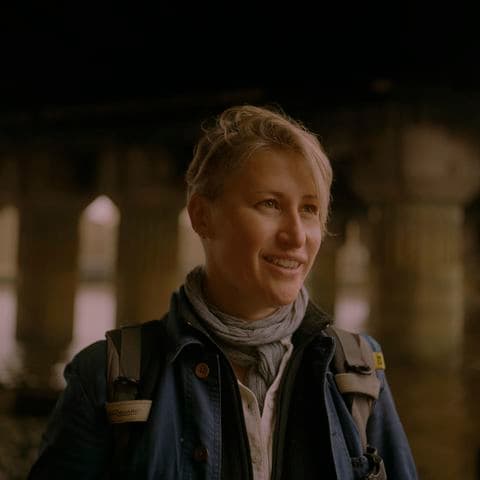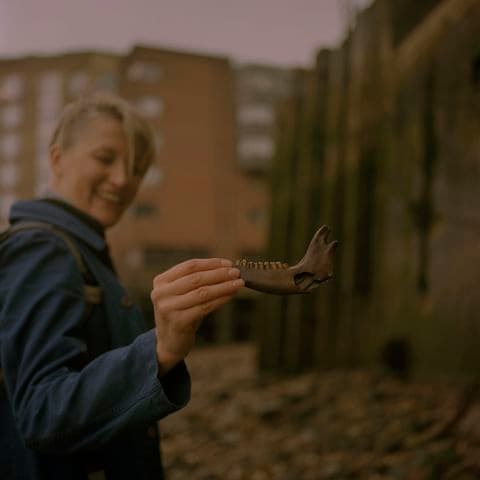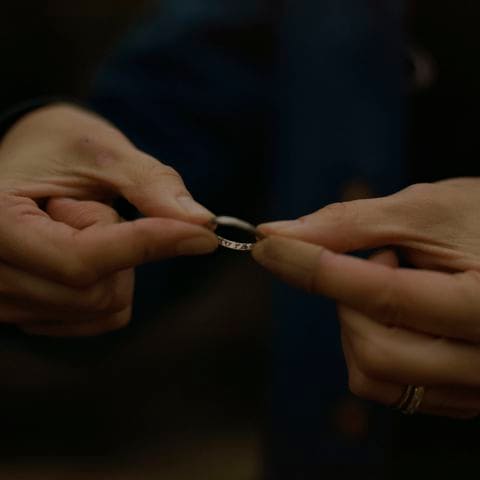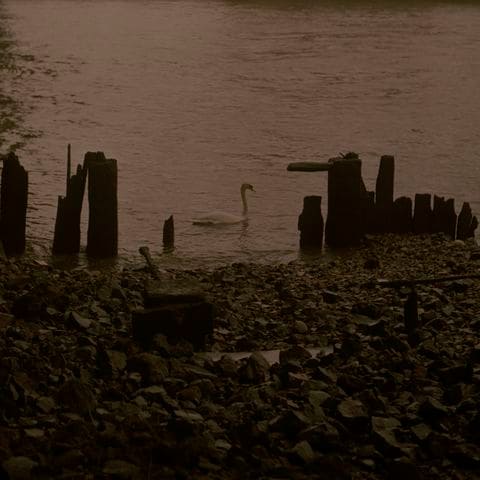Roman roofing. Tudor shoes. London’s mudlarks find castoff history along the Thames.
LONDON — It’s not the customary attire seen in the City, the hub of global finance, but here comes treasure hunter and time traveler Lara Maiklem, striding down the lane from the Cannon Street tube station, outfitted in dungarees, mud boots and kneepads, snapping on a pair of no-nonsense surgical gloves.
Like, right, let’s get to it. Snap!
We meet outside a swish bar called, appropriately, The Banker, though our business lies not at the drink rail but a few steps away, down seaweedy stairs that transport us from the 21st century and its global pandemic into a vast past at our feet.
This is the foreshore of the River Thames, a spooky, mysterious and temporary beach that appears and disappears twice a day, as the river — milky gray, like old, cold tea — rises and falls with the powerful tides. The constant churn brings to the surface objects that have been preserved in the mud. For those with the eyes to see, this 100-mile stretch is “England’s longest archaeological landscape.”
“Watch your step,” Maiklem advises.
The hobbyist archaeologist has spent 15 years of low tides here, as a devoted member of a secretive, alternatively competitive and generous, obsessive tribe known as the mudlarks.
In the early 19th century, the term described a foul and wretched profession, pursued by desperate children and old women, who scavenged the putrid muck of the Thames for anything of a penny’s value, such as a lump of coal or a piece of wood.
 Maiklem, who has been scouring the Thames for 15 years, likes feeling connected to people who lived long ago. (Tori Ferenc for The Washington Post)
Maiklem, who has been scouring the Thames for 15 years, likes feeling connected to people who lived long ago. (Tori Ferenc for The Washington Post) Today, the Thames is no longer an open sewer. And the amateur mudlarks who gently prod the shore are on a quest for castoff history: a tooth scraper from the 18th century, a cut of Spanish glass, or tin tokens from the time of King James II in the late 1600s, sold to support the failing plantations in America.
Maiklem has found them all.
She shares her obsession in a book that has become a surprise bestseller, “Mudlark: In Search of London’s Past Along the River Thames.” And on a day last month, ahead of Britain’s second shutdown, she agreed to take me out onto the foreshore.
[Book review: “Mudlark: In Search of London’s Past Along the River Thames]
Beneath our feet are what at first appear to be just tide-washed sand and stone. Maiklem reaches down and picks up a piece of red clay with a thick lip. It’s a bit of Roman roof.
“They were the first to mass-produce this,” she says, following the invasion of A.D. 43, led by Roman Emperor Claudius, whose legions founded the city Londinium along the shores of the Thames.
There’s so much roofing material that the mudlarks rarely keep a piece, but what Maiklem covets are fragments of tile with a story. She’s found pieces with the impression of a child’s fingers, with cat paw prints, left by those long gone who strayed across the drying clay.

Maiklem strives to disturb the foreshore as little as possible, focusing on what’s visible without digging.

She holds a piece of Roman roof tile.

Knee pads allow her to “kneel with my nose barely inches from the foreshore.”

The Thames in London’s city center is narrowed by stout embankments built against the flood. (Tori Ferenc for The Washington Post)
TOP LEFT: Maiklem strives to disturb the foreshore as little as possible, focusing on what’s visible without digging. TOP RIGHT: She holds a piece of Roman roof tile. BOTTOM LEFT: Knee pads allow her to “kneel with my nose barely inches from the foreshore.” BOTTOM RIGHT: The Thames in London’s city center is narrowed by stout embankments built against the flood. (Tori Ferenc for The Washington Post)
Across the river is the Tate Modern museum and London City Hall and the replica of Shakespeare’s Globe Theatre. On our side are the ruins of Walbrook Wharf, where a trash barge nests on a pebbly beach.
To Maiklem’s practiced eyes, the foreshore is a midden, filled with Elizabethan pennies from Shakespeare’s day, beads used in Africa as part of the slave trade, and scores of clay pipes. While the pipe bowls are rare, the stems are plentiful, ranging in date from 1580 through the early 1900s. Once Maiklem points out what to look for — short lengths of bone-white stem — I see them all over.
“I love the ones where you can see someone’s teeth marks,” she says.
Mudlarking along the Thames is a highly regulated activity, requiring the proper permits. Any objects that could be of archaeological interest must be reported to the finds liaison officer with the Portable Antiquities Scheme at the Museum of London.
The mudlarks have filled museum collections with Mesolithic hand axes, Bronze Age swords and early surgical instruments. Many early treasures were dug up by riverside excavations and sold to Victorian antiquarians, who passed their collections on. Today, most of the finds are not worth much, monetarily.
 Maiklem holds a piece of animal jaw found along the Thames. (Tori Ferenc for The Washington Post)
Maiklem holds a piece of animal jaw found along the Thames. (Tori Ferenc for The Washington Post) Maiklem says it’s not unusual to find scorched building material — some of it, she imagines, dating back to the Great Fire of 1666. There’s lots of bone, too. Pig, cow and horse teeth. “Hard to know whether 1930 or 1530,” she says.
She once found an old human skull covered in periwinkle clams, though such discoveries are rare.
There are newer remains, as well. On average, 50 people each year die in the River Thames, the majority by suicide. I ask what happens when a body is discovered. I’m told the proper authorities arrive with DNA kits and body bags.
Maiklem lifts up a billiard ball-size chunk of white rock that looks familiar. It’s coral from the West Indies, used as ballast in British sailing ships.
It’s all so random, such a jumble, which is why the foreshore isn’t really a proper archaeological site. Everything is too mixed up. Neolithic flint might be found near a Tudor shoe, medieval buckles in the same vicinity as Victorian toys. There’s no layers, no context. It’s a drawer full of curios spanning centuries.
Before I ventured out with Maiklem, I thought the objects found along the Thames were mostly dropped in the river by accident, someone fumbling in a boat on a dark night in the 16th century. But much of the material is refuse shoveled up from bins and streets and dumped intentionally, to build up the banks, to create beds to dock barges.

Among Maiklem’s favorite finds over the years are this 17th-century crotal bell, which would have been used on a horse-drawn carriage.

A silver sixpence, bent into an “S,” probably dates to the early 18th century.

The constant churning of the riverbed mixes objects from different eras.

A piece of late-medieval glass, like this one, might be found near a Tudor shoe. (Tori Ferenc for The Washington Post)
TOP LEFT: Among Maiklem’s favorite finds over the years are this 17th-century crotal bell, which would have been used on a horse-drawn carriage. TOP RIGHT: A silver sixpence, bent into an “S,” probably dates to the early 18th century. BOTTOM LEFT: The constant churning of the riverbed mixes objects from different eras. BOTTOM RIGHT: A piece of late-medieval glass, like this one, might be found near a Tudor shoe. (Tori Ferenc for The Washington Post)
Maiklem calls me over to where she is bent down and peering at a patch of sand.
“Do you see?” she asks. I do not.
With a fingertip, she flicks a bit of sand away and begins to lift from the beach one, two, three pins.
“Think about it,” she says. Before buttons, before zippers, everything was pinned. These pins were used by people. The objects were so everyday — but so intimate.
Maiklem tells me she came by her mudlarking passion by accident. One evening, after a party, she walked onto the foreshore and was smitten. “I hated history in school. Kings, queens, battles, dates,” she says.
But mudlarking offers a tangible proof, a connection. Our ancestors were real. “You can find stuff you don’t see in a museum, and you can see things for yourself, those tooth marks on a clay pipe, a fingerprint on a roof tile, and you can make up any story you want. Nobody really knows how it ended up in the river.”
She calls mudlarking “a hobby for the archaeologically curious.” A mudlark doesn’t need an Oxford degree. It’s history for the everyman.
“It is strange times now. And life so hurried, this slows you way down. The city is above, and feels very far away,” she says. “You can spend 30 minutes looking at a few square meters if you had the mind to do so.”
 Rings inscribed with poetry were common tokens of affection in the 14th century. (Tori Ferenc for The Washington Post)
Rings inscribed with poetry were common tokens of affection in the 14th century. (Tori Ferenc for The Washington Post) And she does. In her book, Maiklem describes how mudlarks speak of “getting your eye in,” that the harder you look, the less you find, that you have to relax “and let yourself see what shouldn’t be there.”
You begin an obsession by picking out the larger pieces of the puzzle, Maiklem says. “But to find the smaller things you need to get much closer and this has become my preferred method,” she writes. “I kneel with my nose barely inches from the foreshore and immerse myself in it completely, filling every sense.”
In this “Lilliputian world,” she writes, she has found precious treasures, such as a little twist of jewelry, turned black with age. It was a posy ring, perhaps from the 14th century, when friends and lovers gave them as tokens, inscribed with a line of “posy,” or poetry.
The ring Maiklem found read, “I LIVE IN HOPE X.” Which is pretty right, for a mudlark.
 London, established by the Romans 2,000 years ago, has been built up and filled in, century by century, along the river. (Tori Ferenc for Washington Post)
London, established by the Romans 2,000 years ago, has been built up and filled in, century by century, along the river. (Tori Ferenc for Washington Post) Photo editing by Chloe Coleman. Design by J.C. Reed.






